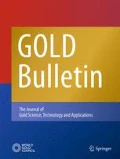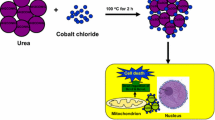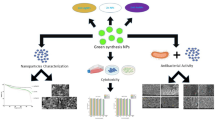Abstract
The current report discloses the development of gold, silver, and iron nanoparticles using berberine by green synthesis and its evaluation for antimicrobial activity and in vitro cytotoxicity against colon cancer and human cervical cancer cells. The prepared nanoparticles were characterized by Fourier transform infrared (FT-IR) spectroscopy, scanning electron microscopy (SEM), transmission electron microscopy (TEM), and X-ray diffraction analysis. The characterization of results of the prepared nanoparticles satisfied the distinctive properties of the potent nanodrug. The antimicrobial potential was exhibited by all the prepared nanoparticles against the selected microbial strains. The zone of inhibition (mm) exhibited by gold nanoparticles biosynthesized using berberine (BAuNPs) was 15.66 ± 0.47 mm against Pseudomonas aeruginosa, 15.0 ± 1.41 against Escherichia coli, and 15.33 ± 1.24 mm against Staphylococcus aureus. The cytotoxicity study exhibited promising results as compared to pure berberine. The results of the MTT assay of gold nanoparticles against COLO320DM exhibited 92.27 ± 0.14% inhibition, whereas in the case of the SRB assay, it revealed 89.72 ± 0.29% inhibition as compared to other nanoparticles and pure berberine. For Hela cell lines, in the case of the MTT assay, BAuNPs exhibited 92.13 ± 0.64% inhibition while in the SRB assay, it revealed 85.56 ± 0.39% inhibition. The results of the Trypan blue assay revealed that BAuNPs showed 76.54 ± 1.00% inhibition against the COLO320DM cell line, whereas in the case of Hela cell lines, 78.03 ± 1.47% inhibition was observed. The effect exhibited by BAuNPs may be attributed to increased production of reactive oxygen species by treated carcinoma cells that results in oxidation of vital constituents which ultimately causes death of the cell. Thus, these in vitro results demonstrate the promising therapeutic applications of the BAuNPs in nanomedicine.





Similar content being viewed by others
References
Satpathy S, Patra A, Ahirwar B, Delwar Hussain M (2018) Antioxidant and anticancer activities of green synthesized silver nanoparticles using aqueous extract of tubers of Pueraria tuberosa. Artif Cells, Nanomedicine Biotechnol 46:S71–S85. https://doi.org/10.1080/21691401.2018.1489265
Shejawal KP, Randive DS, Bhinge SD et al (2020) Green synthesis of silver and iron nanoparticles of isolated proanthocyanidin: its characterization, antioxidant, antimicrobial, and cytotoxic activities against COLO320DM and HT29. J Genet Eng Biotechnol 18:1–11. https://doi.org/10.1186/s43141-020-00058-2
Chavan RR, Bhinge SD, Bhutkar MA et al (2020) Characterization, antioxidant, antimicrobial and cytotoxic activities of green synthesized silver and iron nanoparticles using alcoholic Blumea eriantha DC plant extract. Mater Today Commun 24:101320. https://doi.org/10.1016/j.mtcomm.2020.101320
Patil OA, Patil IS, Mane RU et al (2018) Formulation optimization and evaluation of cefdinir nanosuspension using 23 factorial design. Marmara Pharm J 22:587–598. https://doi.org/10.12991/jrp.2018.101
Shejawal KP, Randive DS, Bhinge SD et al (2021) Green synthesis of silver, iron and gold nanoparticles of lycopene extracted from tomato: their characterization and cytotoxicity against COLO320DM, HT29 and Hella cell. J Mater Sci Mater Med 32:19. https://doi.org/10.1007/s10856-021-06489-8
Randive DS, Bhutkar MA, Bhinge SD et al (2019) Hypoglycemic effects of Lagenaria siceraria, Cynodon dactylon and Stevia rebaudiana extracts. J HerbMed Pharmacol 8(1):55–51. https://doi.org/10.15171/jhp.2019.09
Randive DS, Shejawal KP, Bhinge SD et al (2020) Green synthesis of gold nanoparticles of isolated citrus bioflavonoid from orange: characterization and in vitro cytotoxicity against colon cancer cell lines colo 320DM and Ht29. Indian Drugs 57:61–69
Randive D, Sayyad S, Bhinge S, Bhutkar M (2016) Preparation of Arjunāriṣṭa-using microbes isolated from Woodfordia fruticosa flowers (Dhayati). Anc Sci Life 36:42. https://doi.org/10.4103/0257-7941.195405
Sayyad SF, Randive DS, Jagtap SM et al (2012) Preparation and evaluation of fermented ayurvedic formulation: Arjunarishta. J Appl Pharm Sci 2:122–124. https://doi.org/10.7324/JAPS.2012.2521
Randive DS, Bhinge SD, Bhutkar MA et al (2020) Formulation and evaluation of herbal cough remedy from extract of Calendula officinalis L. Indian Drugs 57:52–58
Randive DS, Bhinge SD, Bhutkar MA et al (2020) Formulation and evaluation of lipstick, rouge and eye shadow using colored pigment from the extract of Piper Betel and Acacia Catechu. Indian Drugs 57:59–66
Bhutkar MA, Bhinge SD, Randive DS, Wadkar GH (2017) Hypoglycemic effects of Berberis aristata and Tamarindus indica extracts in vitro. Bull Fac Pharmacy, Cairo Univ 55:91–94. https://doi.org/10.1016/j.bfopcu.2016.09.001
Neag MA, Mocan A, Echeverría J et al (2018) Berberine: botanical occurrence, traditional uses, extraction methods, and relevance in cardiovascular, metabolic, hepatic, and renal disorders. Front Pharmacol 9:1–30. https://doi.org/10.3389/fphar.2018.00557
Tang J, Feng Y, Tsao S et al (2009) Berberine and Coptidis rhizoma as novel antineoplastic agents: a review of traditional use and biomedical investigations. J Ethnopharmacol 126:5–17. https://doi.org/10.1016/j.jep.2009.08.009
Inoue K, Kulsum U, Chowdhury SA et al (2005) Tumor-specific cytotoxicity and apoptosis-inducing activity of berberines. Anticancer Res 25:4053–4059
Kulkarni N, Muddapur U (2014) Biosynthesis of metal nanoparticles: a review. J Nanotechnol 2014:1–8. https://doi.org/10.1155/2014/510246
Bharadwaj MS, Prem K, Satyanandam K, Raju AI (2016) Green synthesis of iron nanoparticles using Albizia lebbeck leaves for synthetic dyes decolorization. Int J Sci Eng Technol Res 5:3429–3434
Zargar M, Hamid AA, Bakar FA et al (2011) Green synthesis and antibacterial effect of silver nanoparticles using Vitex negundo L. Molecules 16:6667–6676. https://doi.org/10.3390/molecules16086667
Elavazhagan T, Arunachalam KD (2011) Memecylon edule leaf extract mediated green synthesis of silver and gold nanoparticles. Int J Nanomedicine 6:1265–1278. https://doi.org/10.2147/ijn.s18347
Arunachalam KD, Arun LB, Annamalai SK, Arunachalam AM (2014) Biofunctionalized gold nanoparticles synthesis from Gymnema sylvestre and its preliminary anticancer activity. Int J Pharm Pharm Sci 6:423–430
Bhinge SD, Bhutkar MA, Randive DS et al (2019) Formulation and evaluation of polyherbal gel containing extracts of Azadirachta indica, Adhatoda vasica, Piper betle, Ocimum tenuiflorum and Pongamia pinnata. Marmara Pharm J 23:44–54. https://doi.org/10.12991/jrp.2018.107
Bhinge SD, Bhutkar MA, Randive DS et al (2017) Formulation development and evaluation of antimicrobial polyherbal gel. Ann Pharm Fr 75:349–358. https://doi.org/10.1016/j.pharma.2017.04.006
Randive DS, Bhinge SD, Jadhav NR et al (2020) Assessment of antimicrobial efficacy of kohl/kajal prepared by different Indian methods against selected microbial strains. Int J Curr Pharm Res 12:37–44. https://doi.org/10.22159/ijcpr.2020v12i3.38302
Mosmann T (1983) Rapid colorimetric asay for cellular growth and survival: application to proliferation and cytotoxicity assays. J lmmunological Methods 65:55–63. https://doi.org/10.1039/c6ra17788c
Shejawal KP, Randive DS, Bhinge SD et al (2021) Functionalized carbon nanotube for colon - targeted delivery of isolated lycopene in colorectal cancer: in vitro cytotoxicity and in vivo roentgenographic study. J Mater Res. https://doi.org/10.1557/s43578-021-00431-y
Randive DS, Gavade AS, Shejawal KP et al (2021) Colon targeted dosage form of capecitabine using folic acid anchored modified carbon nanotube: in vitro cytotoxicity, apoptosis and in vivo roentgenographic study. Drug Dev Ind Pharm 26:1–12. https://doi.org/10.1080/03639045.2021.1994988
Aghel N, Ramezani Z, Amirfakhrian S (2011) Isolation and quantification of lycopene from: tomato cultivated in Dezfoul. Iran Jundishapur J Nat Pharm Prod 6:9–15
Chen C-X, Mu S (2002) The electrochemical preparation of polyphenol with conductibility. Chinese J Polym Sci 20:309–316
Sowani H, Mohite P, Damale S et al (2016) Carotenoid stabilized gold and silver nanoparticles derived from the Actinomycete Gordonia amicalis HS-11 as effective free radical scavengers. Enzyme Microb Technol 95:164–173. https://doi.org/10.1016/j.enzmictec.2016.09.016
Nguyen HYT, Vo BHT, Nguyen LTH et al (2013) Extracts of Crinum latifolium inhibit the cell viability of mouse lymph oma cell line EL4 and induce activation of anti-tumour activity of macrophages in vitro. J Ethnopharmacol 149:75–83. https://doi.org/10.1016/j.jep.2013.06.002
Vo TT, Nguyen TTN, Huynh TTT, et al (2019) Biosynthesis of silver and gold nanoparticles using aqueous extract from crinum latifolium leaf and their applications forward antibacterial effect and wastewater treatment. J Nanomater 2019https://doi.org/10.1155/2019/8385935
Hussein J, El-Naggar ME, Fouda MMG et al (2020) The efficiency of blackberry loaded AgNPs, AuNPs and Ag@AuNPs mediated pectin in the treatment of cisplatin-induced cardiotoxicity in experimental rats. Int J Biol Macromol 159:1084–1093. https://doi.org/10.1016/j.ijbiomac.2020.05.115
Rao PV, Nallappan D et al (2016) Phytochemicals and biogenic metallic nanoparticles as anticancer agents. Oxid Med Cell Longev 2014:1–15. https://doi.org/10.1155/2016/3685671
Acknowledgements
The authors are thankful to Hon. Secretary of KE Society Kasegaon and Principal of Rajarambapu College of Pharmacy, Kasegaon, Sangli, Maharashtra, for providing the facilities. We are also thankful to the managing director of Influx Healthcare, Mumbai, for providing pure phytoconstituent markers and Dr. Sandip Patil, MD (Biocyte Institute of Research and Development (BiRD), Sangli (MS).
Funding
The research work is supported under Research Grant to a college teacher by Shivaji University (SU), Kolhapur, MS, India, as an encouragement for the academic young scientist, and the sanction letter number is SU/C & UD Section UGK/&/1028 (date 29 Dec 2018).
Author information
Authors and Affiliations
Contributions
MAB made substantial contributions to collection and interpretation of data and to manuscript preparation/writing manuscript and performed the experiment. DSR, SDB, and KPS made substantial contributions to supervising experimental work. GHW and SST made substantial contributions to correction of the manuscript. All data were generated in-house, and no paper mill was used. All authors agree to be accountable for all aspects of work ensuring integrity and accuracy.
Corresponding author
Ethics declarations
Conflict of interest
The authors declare no competing interests.
Additional information
Publisher's note
Springer Nature remains neutral with regard to jurisdictional claims in published maps and institutional affiliations.
Rights and permissions
About this article
Cite this article
Bhutkar, M.A., Randive, D.S., Bhinge, S.D. et al. Development of gold, silver, and iron nanoparticles using isolated berberine: its characterization and antimicrobial and cytotoxic activities against COLO320DM and Hela cells. Gold Bull 55, 93–103 (2022). https://doi.org/10.1007/s13404-022-00309-9
Received:
Accepted:
Published:
Issue Date:
DOI: https://doi.org/10.1007/s13404-022-00309-9




